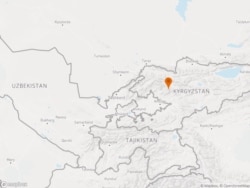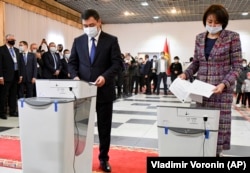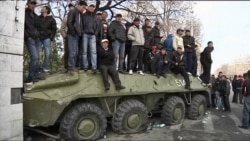
Any farmer can explain the problems that come with being dependent on generous rain clouds to water the crops.
It seems there is often either too little or too much.
Many people in Kyrgyzstan are about to face the consequences of too little water. In a country where 90 percent of the electricity is generated by hydropower facilities, the problems caused by a long drought do not end in the farmers’ fields but could extend to neighboring countries.
Kyrgyzstan’s Toktogul hydropower plant (HPP) was opened in 1975, during the Soviet era. It took some 15 years to prepare the massive reservoir and fill it before the four 300 megawatt (MW) units could start producing energy.
It was one of the earliest attempts to tap into Kyrgyzstan’s hydropower potential, which even today is only being used at 10 percent of its capability.
The plant has suffered several problems in recent years associated with its aging equipment.
In December 2015, one of the turbines shut down and, in less than a week, three of the four units had stopped functioning, forcing authorities to ration electricity during the coldest part of winter. The HPP is currently undergoing renovation work that aims to replace or rehabilitate the old equipment and bring the total output up to 1440 MW.
The Toktogul reservoir is in the western Kementub Valley, along the Naryn River that eventually flows into Uzbekistan and merges into one of the two great rivers of Central Asia, the Syr Darya (the other is the Amu Darya), before snaking into Kazakhstan.
The Toktogul HPP provides some 40 percent of Kyrgyzstan’s electricity, but the water level at the reservoir has been falling in recent years, which will soon result in the reduction and maybe the suspension of operations.
In August 2017, the reservoir was filled to the maximum, with 19.5 billion cubic meters (bcm) of water. But on March 30, 2021, Kyrgyz Energy Minister Kubanychbek Turdubaev said the level had dropped to 8.7 bcm.
The new leadership in Kyrgyzstan has been promising to decrease the country’s debt and any additional financial burden is especially unwelcome at the moment.
Turdubaev called 8.5 bcm the “critical level” where the operation of the Toktagul HPP would be affected. The water level might reach this critical level very soon, judging by the rate it is falling.
On March 22, Kyrgyzstan’s main electricity provider, Elektricheskiye Stantsii, said the water level at Toktogul was 8.83 bcm.
Turdubaev noted that the amount of water spilling out of the reservoir has exceeded the amount coming into it for several years and "every year the volume of water is decreasing by 1.5-1.8 bcm."
The simplest way to correct the problem would be to close the spillways out of the reservoir for brief periods and allow water to accumulate. But while Toktogul is a source of domestic power for Kyrgyzstan, its water is needed in two other countries.
Some 80 percent of the water that leaves the Toktogul reservoir goes into Uzbekistan, where it joins the Syr Darya.
This water is desperately needed for agriculture in both of the downstream countries. Kazakhstan has promised to send up to 1 billion kilowatt hours (kWh) of electricity exports, with Uzbekistan offering 750 million kWh to help Kyrgyzstan with its power problem.
The idea is that this will allow Kyrgyzstan to cut back on the water used for the Toktogul HPP. All three parties seem to be counting on melting snow and spring rain to raise the water level at Toktogul, though there is no guarantee this will happen.

In the meantime, Kazakhstan and Uzbekistan also want to ensure sufficient water from the reservoir for this year’s crops.
As for electricity imports, there was reportedly a deal with Uzbekistan for a swap, whereby Uzbekistan will export electricity to Kyrgyzstan from March to October and again in March and April next year.
In return, Kyrgyzstan has pledged to send electricity to Uzbekistan during the June-August period for 2021-2023. But Turdubaev indicated Kyrgyzstan will have to pay both countries for electricity imports and said his cash-strapped country cannot immediately make those payments.
“We explained the situation to them and asked for [electricity supplies] on credit,” Turdubaev said.
Kazakhstan and Uzbekistan have pledged to charge low rates for the electricity, but the new leadership in Kyrgyzstan has been promising to decrease the country’s debt and any additional financial burden is especially unwelcome at the moment.
Besides that, electricity imports from Kazakhstan and Uzbekistan will not be enough to cover the shortfall from the low water level at the Toktogul HPP.
Turdubaev said other power plants that normally reduce their output during the warm months when HPPs operate will have to keep operating at or near winter capacity, and he specifically named the Bishkek thermal power plant (TPP).
The coal-burning Bishkek TPP is thought to be a major contributor to air pollution in the Kyrgyz capital, which at times during this winter had some of the worst air pollution of any major city in the world.
The clean electricity produced by Toktogul helps ease pollution problems in Bishkek and other areas of Kyrgyzstan during the warmer months of the year, but this year the summer skies above Kyrgyzstan’s capital might be even browner than usual.
Longer term, the current drought is something Kyrgyzstan needs to consider in its grand plans to become an electricity exporter. Kyrgyzstan has exported electricity to its immediate neighbors during years when there was sufficient water for all of the country’s HPPs.
But the country has much bigger plans.
President Sadyr Japarov attended a ceremony in Kyrgyzstan’s southern village of Kara-Bulak on April 3 to launch construction of the first high-voltage power transmission line for the Central Asia-South Asia project, better known as CASA-1000.
CASA-1000 aims to bring some 1,300 MW of surplus electricity generated during the summer months from HPPs in Kyrgyzstan and Tajikistan to Afghanistan (300 MW) and Pakistan (1000 MW). The project is tentatively due to launch in 2023.
But the current situation at the Toktogul reservoir is a reminder that the water needed to operate HPPs is not guaranteed to be constant. Some in Kyrgyzstan have also noted domestic demand for power is growing in the country and that that should be satisfied before any electricity is exported.











